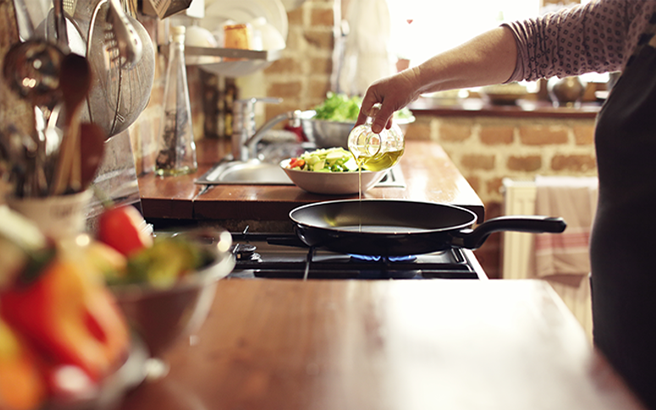Oils and fats are a kitchen staple. But there’s a lot of conflicting information regarding how healthy each of them is. With so many to choose from, how do we know what we should be using?
Generally, if a fat is solid at room temperature, such as butter, coconut, lard and ghee, it is higher in saturated fats. These type of fats raise levels of “bad” LDL cholesterol, which isn’t good for our heart health. Therefore, we should limit how much saturated fat we consume.
If a fat is liquid at room temperature, such as olive and rapeseed oils, it has a higher proportion of unsaturated fats: monounsaturated and polyunsaturated – which are sometimes referred to as “good” fats. These fats (when they replace saturated-rich food such as butter in your diet) can have a favourable effect on our blood cholesterol levels, and help maintain a healthy heart.
Will eating oils and fats increase my risk of cancer?
World Cancer Research Fund has found no evidence that eating vegetable and seed oils in moderation increases the risk of cancer. In fact, a small amount of fat is essential and helps the body absorb vitamins A, D and E.
However, fats and oils are high in calories and are often found in processed foods such as cakes, pastries and biscuits. We know that frequently consuming high-calorie processed food can contribute to weight gain, overweight and obesity, which in turn can increase your risk of at least 12 different cancers.
“As part of a healthy diet, choose fats and oils lower in saturated fat and higher in unsaturated fats, in moderation. While a certain amount of fat is essential for our health, we should watch how much we use as it’s high in calories. Choosing the right type of oil or fat for your meal can help make sure that your dish is both delicious and nutritious!”
– Alison Bate, Registered Associate Nutritionist
How does cooking affect oils?
The term “smoke point” refers to the temperature at which oil begins to smoke. It occurs when components of the fats start to break down, which leads to the formation of compounds called free radicals that can be harmful to our health.
This can happen if you use an oil with a low smoke point for cooking at high temperatures. Before using any oil, make sure its smoke point can handle the cooking method you plan to use.
As a general rule of thumb, oils with a lower smoke point are best suited to cooking at low temperatures, while those with a higher smoke point are best suited to cooking at higher temperatures, such as frying.
Fats to avoid
Trans fat, a type of fat found in partially hydrogenated vegetable oil (a process where a liquid oil is turned into a solid fat), is particularly harmful to our health. It raises levels of “bad” LDL cholesterol and lowers the “good” HDL cholesterol. While many food manufacturers and retailers no longer use partially hydrogenated vegetable oils, it’s a good idea to check the label just in case.


